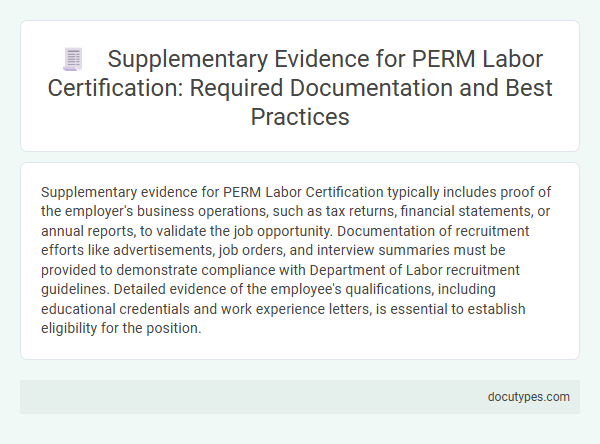Supplementary evidence for PERM Labor Certification typically includes proof of the employer's business operations, such as tax returns, financial statements, or annual reports, to validate the job opportunity. Documentation of recruitment efforts like advertisements, job orders, and interview summaries must be provided to demonstrate compliance with Department of Labor recruitment guidelines. Detailed evidence of the employee's qualifications, including educational credentials and work experience letters, is essential to establish eligibility for the position.
Introduction to Supplementary Evidence for PERM Labor Certification
Supplementary evidence for PERM Labor Certification supports the employer's ability to meet Department of Labor requirements. This evidence strengthens the application by providing additional proof of recruitment efforts and job conditions.
Common supplementary documents include recruitment advertisements, job descriptions, and employer financial records. Proper submission of these materials helps to verify compliance and avoid application delays or denials.
Overview of PERM Labor Certification Requirements
PERM Labor Certification requires employers to demonstrate a genuine need for foreign labor by proving no qualified U.S. workers are available for the position. Supplementary evidence includes detailed job descriptions, recruitment efforts, and wage determinations that comply with Department of Labor standards. Employers must submit documentation such as recruitment reports, resumes of applicants, and prevailing wage information to support the certification application.
Importance of Supplementary Documentation in PERM Applications
Supplementary evidence plays a crucial role in strengthening PERM labor certification applications by validating the employer's recruitment efforts and job requirements. Providing detailed documentation such as recruitment reports, job advertisements, and applicant resumes helps ensure compliance with Department of Labor regulations.
Employers must submit evidence demonstrating the inability to find qualified U.S. workers, which supports the legitimacy of the foreign worker's need. Accurate supplementary documentation minimizes the risk of application denial and expedites the certification process.
Key Types of Supplementary Evidence Accepted by DOL
| Supplementary Evidence Type | Description | Purpose |
|---|---|---|
| Advertisements for the Job Opening | Copies of print or online job postings used to recruit U.S. workers | Proves active recruitment efforts required by the Department of Labor (DOL) |
| Recruitment Report | Detailed summary of recruitment results, including number of applicants and reasons for rejection | Demonstrates that no qualified U.S. worker was available or willing |
| Payroll Records | Records indicating current employees' wages and positions | Confirms compliance with prevailing wage requirements and job classification |
| Prevailing Wage Determination | Official wage level documentation issued by DOL or state agency | Supports the wage offered meets or exceeds legal standards |
| Employer's Financial Documents | Tax returns, financial statements, or balance sheets | Verifies the employer's ability to pay the offered wage |
| Copy of Job Description | Detailed roles, responsibilities, and minimum qualifications | Clarifies the nature of the position for which certification is requested |
| Summary of Job Fair and Other Recruitment Methods | Details of additional recruitment efforts beyond standard ads | Provides broader evidence of attempts to find qualified U.S. workers |
Documentation for Proving Employer’s Business Necessity
Supplementary evidence for PERM Labor Certification must clearly establish the employer's business necessity behind job requirements. Proper documentation proves that specific qualifications or experience are indispensable for job performance.
Documentation should include detailed job descriptions outlining why each requirement is essential. Employer statements explaining how each criterion relates directly to job duties are crucial. Supporting evidence such as organizational charts, industry standards, and market analysis further substantiates the business necessity claim.
Evidence Supporting Recruitment Efforts and Results
Evidence supporting recruitment efforts is crucial for the PERM Labor Certification process to demonstrate that genuine attempts were made to hire U.S. workers. Proper documentation of these recruitment activities and their results ensures compliance with Department of Labor requirements.
- Job advertisements - Copies of all recruitment ads published in newspapers, online job portals, or trade journals must be submitted to verify the position was openly advertised.
- Recruitment report - A detailed recruitment report outlining the recruitment steps taken, interviews conducted, and lawful job-related reasons for rejecting U.S. applicants is required.
- Applicant resumes and interview notes - Documentation of resumes received and notes from interviews help prove that qualified U.S. workers were considered and lawfully rejected.
Required Proof of Employer’s Financial Ability to Pay
The PERM Labor Certification requires employers to provide supplementary evidence demonstrating their financial ability to pay the offered wage. Acceptable proof includes annual reports, federal tax returns, or audited financial statements. These documents verify the employer's capacity to fulfill wage obligations for the sponsored foreign worker.
Best Practices for Organizing PERM Supplementary Evidence
What supplementary evidence is required for PERM Labor Certification? Supporting documents must verify the facts stated in the application and demonstrate compliance with Department of Labor regulations. Organizing these materials clearly and systematically enhances the review process and reduces the risk of delays or denials.
How can you best organize PERM supplementary evidence? Categorize documents by type, such as recruitment efforts, educational credentials, and work experience verifications. Use labeled folders or digital files to maintain easy access and ensure all evidence corresponds directly to the application details.
Common Pitfalls and Mistakes in Submitting PERM Documentation
Submitting supplementary evidence for PERM Labor Certification requires careful attention to detail to avoid delays or denials. Common pitfalls often involve incomplete or inconsistent documentation that fails to meet Department of Labor standards.
- Missing Detailed Job Descriptions - Employers frequently omit specific duties and minimum requirements, weakening the application.
- Inconsistent Wage Documentation - Providing wage information that does not match prevailing wage determinations can trigger scrutiny.
- Lack of Proof for Recruitment Efforts - Failure to submit accurate and thorough recruitment evidence undermines the good faith recruitment requirement.
Ensuring all supplementary evidence aligns precisely with PERM guidelines is essential for a successful Labor Certification process.
What Supplementary Evidence Is Required for PERM Labor Certification? Infographic

